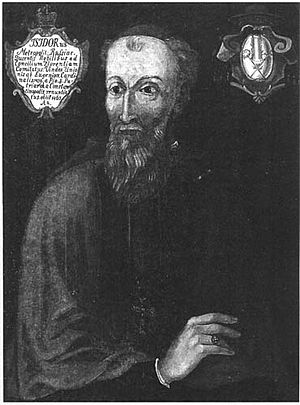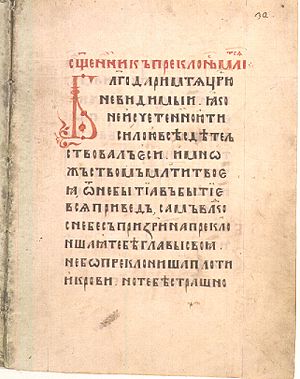Isidore of Kiev facts for kids
Isidore of Kiev, also known as Isidore of Thessalonica (born 1385 – died April 27, 1463), was an important church leader from the Byzantine Empire. From 1437 to 1441, he served as the Metropolitan of Kiev and all Rus' for the Patriarchate of Constantinople in the Eastern Orthodox Church. He strongly supported the Union of Florence, which aimed to unite the Eastern Orthodox and Catholic Churches. He announced this union in Hagia Sophia on December 12, 1452. In the Latin Church, Isidore became a cardinal bishop and held titles like Archbishop of Cyprus and Latin Patriarch of Constantinople.
Quick facts for kids His Eminence Isidore of Kiev |
|
|---|---|
| Latin Patriarch of Constantinople | |
 |
|
| Diocese | Constantinople |
| Enthroned | 20 April 1458 |
| Reign ended | 27 April 1463 |
| Predecessor | Gregory Mammas |
| Successor | Basilios Bessarion |
| Other posts | Cardinal-bishop of Sabina |
| Orders | |
| Consecration | 1437 |
| Created Cardinal | 18 December 1439 |
| Rank | Cardinal bishop |
| Personal details | |
| Born | 1385 Monemvasia, Byzantine Greece, Byzantine Empire |
| Died | 27 April 1463 (aged 77-78) Rome, Papal States |
| Nationality | Greek |
| Denomination | Eastern Catholic (formerly Eastern Orthodox) |
| Previous post |
|
| Coat of arms | |
| Styles of Isidore of Kiev |
|
|---|---|
 |
|
| Reference style | His Eminence |
| Spoken style | Your Eminence |
| Informal style | Cardinal |
| See | Sabina e Poggio Mirteto (suburbicarain) |
Contents
Early Life of Isidore
Isidore was born around 1385 in southern Greece. He later moved to Constantinople, where he became a monk. He rose to become the leader of the St Demetrius monastery.
Isidore was very good at Latin and was known as a skilled theologian. He was also an excellent speaker. From early on, he was keen on the idea of uniting the Eastern and Western Churches.
At this time, the city of Constantinople was under threat from the Ottoman Turks. Its leaders hoped that uniting with Rome would bring help from Western princes. In 1434, Isidore was sent to Basel by Emperor John VIII Palaiologos to start talks with the Council of Basel. He gave a powerful speech about the Roman Empire in Constantinople, but these early efforts did not lead to the churches uniting.
Isidore as Metropolitan of Kiev
In 1437, Isidore was chosen to be the Metropolitan of Kiev and all Rus'. This was a very important position as the head of the Orthodox Church in that region. Emperor John VIII Palaeologus hoped that by bringing the Eastern Orthodox Church in Kievan Rus' closer to the Pope, Constantinople would get protection against the invading Ottoman Turks.
However, Vasili II, the Grand Duke of Moscow, was suspicious of Isidore. He allowed Isidore to attend an important church meeting in Florence in 1439. Vasili II made Isidore promise that he would not betray the Orthodox faith. At this meeting, Isidore strongly supported the union between the Eastern and Western Churches.
After the union agreement was signed, Isidore returned to Eastern Europe.
The Council of Ferrara
Isidore might have been a student of a philosopher named Gemistus Pletho. He traveled with his teacher and two other students, Bessarion and Mark Eugenikos, to attend the Council of Ferrara. This council aimed to bring the Orthodox and Catholic Churches back together.
A large group of church leaders and thinkers left for Ferrara on September 8, 1437. They traveled through Riga and Lübeck, arriving in Ferrara on August 15, 1438. On the journey, Isidore's friendly behavior towards the Latin (Catholic) side caused some concern. At Ferrara, and later in Florence where the council moved in January 1439, Isidore was one of the six main speakers for the Byzantine side. Along with Bessarion, he worked hard for the union and never changed his mind about it.
After the council, Pope Eugene IV made Isidore his special representative for all of Ruthenia and Lithuania. On his way back to Moscow, Isidore learned that he had been made a Cardinal. This was unusual because he was not from the Latin (Catholic) Rite.
In March 1440, from Buda, he sent a letter asking all Rus' bishops to accept the union. But when he finally reached Moscow in 1441, and announced the union in the Kremlin church, he found that Vasili II and most of the bishops and people did not accept it. Vasili II then ordered six Rus' bishops to meet, remove Isidore from his position, and imprison him.
The princes of the Grand Duchy of Moscow rejected the union with Rome. However, Isidore continued to support it. During his first church service in the Dormition Cathedral in the Moscow Kremlin after returning from Italy, Isidore had a type of cross used in the Catholic Church carried in front of the procession. He also mentioned Pope Eugene IV during the prayers and read the decree of unification aloud. Isidore also gave Vasili II a message from the Pope, asking for help to spread the Union in Rus'. Three days later, the Grand Prince arrested Isidore and put him in the Chudov Monastery. Some Rus' church leaders, pressured by Vasili II, criticized Isidore for not giving up the union with Rome.
Isidore's Exile and Later Life
In September 1443, after two years in prison, Metropolitan Isidore managed to escape. He went to Tver, then to Lithuania, and finally to Rome. The Pope welcomed him warmly in 1443. Pope Nicholas V (1447–1455) later sent him to Constantinople as a special representative to arrange the union there in 1452. He also gave Isidore two hundred soldiers to help defend the city. On December 12 of that year, Isidore was able to bring together three hundred Byzantine clergy for a celebration of the short-lived union.
Before the Fall of Constantinople in 1453, Isidore paid for repairs to the city's defenses himself. He was wounded during the early hours of the city's capture. He managed to escape by dressing a dead body in his cardinal's robes. While the Turks paraded the body through the streets, the real cardinal was secretly sent to Asia Minor as a slave with other prisoners. He later found safety in Crete. He wrote several letters describing the events of the siege. In these letters, he warned about the danger of the Turks expanding further and even compared Mehmed II to Alexander the Great.
Isidore returned to Rome in 1455 and became the Bishop of Sabina. He likely adopted the Latin Rite (Catholic practices) at this time. Pope Pius II (1458–1464) later gave him two more titles: Latin Patriarch of Constantinople and Archbishop of Cyprus. However, he couldn't actually use power in these areas. He was the Dean of the Sacred College of Cardinals from October 1461 until his death in 1463.
Isidore in Popular Media
Cardinal Isidore is played by İzzet Çivril in the 2012 film Fetih 1453. In the movie, the Cardinal is shown as a prisoner after Constantinople falls.
He is also played by Lex Gigeroff in the 2006 film The Conclave.
See also
- Metropolis of Kiev, Galicia and all Rus' (1441–1596)
- Greek scholars in the Renaissance
 In Spanish: Isidoro de Kiev para niños
In Spanish: Isidoro de Kiev para niños
Images for kids



